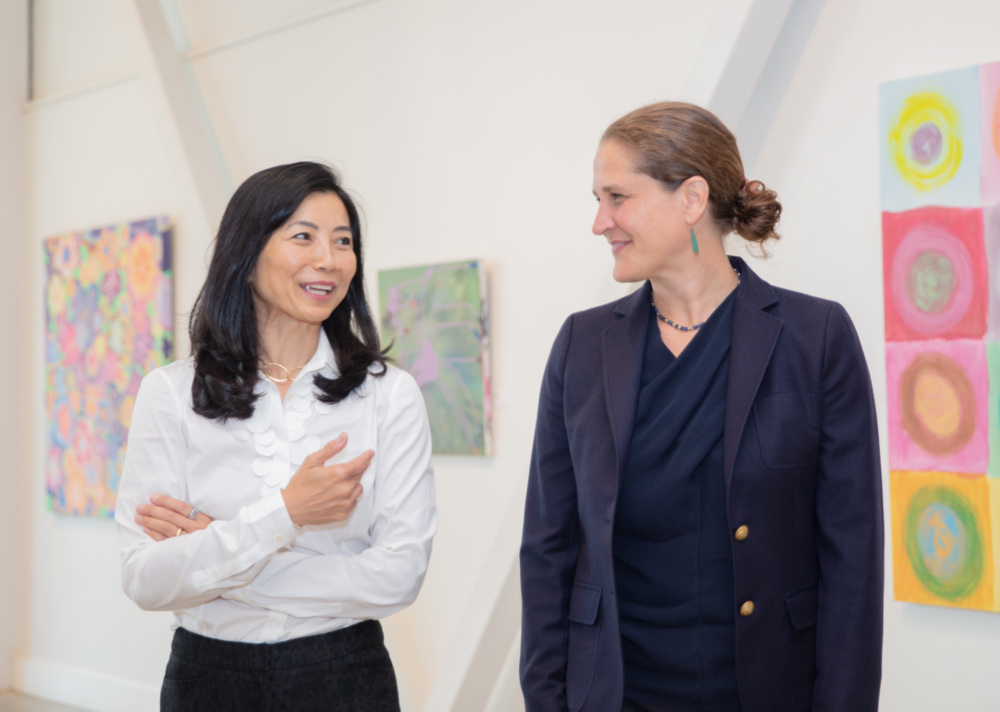

Impact Investments, Social Finance Impact First Fund
Register to Download
You will also receive email updates with publications and other updates from Social Finance. We will not share or sell your personal information.
In 2023, we launched the Social Finance Impact First Fund to make it easy for individuals and organizations to put money to work in solutions to our toughest social and environmental challenges. As we release the Fund’s inaugural Impact Report, Social Finance CEO & Co-Founder Tracy Palandjian and President & COO Kirstin Hill sat down to reflect on why we created the Fund, what we’re learning and what we hope to achieve.
Why did Social Finance create the Impact First Fund?
Tracy: Communities across the country are grappling with challenges too large and complex to solve with philanthropy and traditional investing alone—challenges like the high cost of housing and childcare, climate change, and how to create economic mobility opportunities in rural communities. Market-based solutions to these challenges exist, but they often struggle to raise capital because they don’t check all the boxes of traditional investing. At the same time, foundations and donor-advised funds have more than $1.7 trillion on their balance sheets earmarked for charitable purposes. Most of that money ends up being channeled into traditional investments. We want to mobilize this capital for impact.
Kirstin: There are structural barriers to putting money to work on the innovative solutions Tracy’s talking about. Banks and traditional money managers aren’t set up to prioritize impact over financial returns. The most innovative solutions may come from first-time fund managers without a fund management track record. Or they require capital that doesn’t match the terms of traditional venture capital and private equity. “Greenwashing,” “impact washing,” and a crowded market make it hard to distinguish among these opportunities and to assess the credibility of their impact. And, the barriers to entry are high: it’s hard to build a diversified impact-focused portfolio without dedicating significant financial and human resources to sourcing, managing, and monitoring those investments. We created the Social Finance Impact First Fund to address those barriers.
How does the Fund build on Social Finance’s previous work and other impact investing vehicles in the marketplace?
Tracy: The Fund builds on our experience creating and managing more than 20 impact funds and portfolios, including the UP Fund, the Google Career Certificates Fund, and our Dreamers Graduate Loan Program. These investments place impact front and center—recycling philanthropic capital to deliver a “multiplier effect” of positive impact returns. They’ve given us experience structuring portfolios that optimize impact across multiple stakeholder groups, implementing practical, rigorous systems for impact measurement and management, and using what we learn to evolve our practice and grow the resources available for impact investing. Through our Impact Investing Advisory practice, we’ve partnered with field leaders like Builders Initiative, The Rockefeller Foundation, and Mission Investors Exchange to understand barriers to impact investing for foundations and donor-advised funds. We’ve also worked with philanthropies like The Boston Foundation, Silicon Valley Community Foundation, and Jewish Community Federation & Endowment to build custom portfolios of impact-first investment opportunities for their donors.
Through this work, we recognized the need for an easier on-ramp to impact investing: a one-stop solution that makes it easier for philanthropic individuals and organizations to put money to work, and for impact-driven fund managers and entrepreneurs to access the capital they need to scale their models.
Kirstin: The Impact First Fund is unique because it provides individuals and institutions with immediate access to a diversified, professionally managed portfolio of impact investments across a range of impact themes and private asset classes. We designed it to be evergreen—meaning you can invest at any time—and to offer liquidity opportunities, so donors and investors can access capital for other investments or charitable giving.
The Fund builds on our experience creating and managing more than 20 impact funds and portfolios, including the UP Fund, the Google Career Certificates Fund, and our Dreamers Graduate Loan Program. These investments place impact front and center—recycling philanthropic capital to deliver a 'multiplier effect' of positive impact returns.Tracy Palandjian
How do you think about and measure the impact of the Impact First Fund’s investments?
Kirstin: Our Impact First Fund team is thinking about the impact, both realized and potential, of our investments at each stage of the investment process: from early sourcing through investment and on-going management. We’ve built on leading practices identified by the Impact Management Project, looking at impact data across five dimensions: what, who, how much, contribution, and risk. We also are realistic about what can (and cannot) be measured, especially for funds that are in the early days of operation. We right-size our data collection, so the funds’ first priorities are making good investments that generate positive impact, not collecting and reporting data. We look at the impact that funds have as businesses; and the systems and processes they have for tracking and incentivizing impact.
Tracy: Impact measurement isn’t static—it’s got to be nuanced and it needs to be useful. We want to be candid about what we’re learning and to use our experience to inform future investments here at Social Finance and across the fields of philanthropy and investment.
What kinds of impact are you seeing from the Fund’s initial investments?
Kirstin: The Fund has been up and running for about a year and a half. To date, we’ve made three investments, deploying a total of $10M in capital, all in first-time funds or fund managers. It’s still early, but these funds’ initial investments provide a good sense of what their impact may look like.
For example, our first investment was in Blackstar Stability Distressed Debt Fund, a real estate investment management firm focused on supporting and preserving homeownership, housing stability, and wealth building for low- and moderate-income homeowners. To date, they have helped over 90 families with an average annual household income of $45,000 to own their homes, replacing predatory “contracts for deeds” with traditional mortgages that allow them to build equity. These homeowners have seen an average decrease of 24% in monthly principal and interest payments and an average reduction of $11,000 in their principal balance. That has resulted in an over 22-fold average increase in the net assets of these households.
Our second investment supported Afterglow Climate Justice Fund (Afterglow), which provides catalytic capital to entrepreneurs developing strategies to address and mitigate the impacts of global warming. Afterglow has made five investments to date. One, Solar Holler, is putting solar on the rooftops of homes, businesses, and nonprofit organizations in Appalachia. They’re making solar affordable in the heart of coal country; they’re also creating green jobs that help strengthen the regional economy and reduce its dependence on fossil fuels.
Our latest investment is RuralWorks Partners (RuralWorks), a growth equity fund addressing the wealth and opportunity gap in rural communities by investing in companies that create good jobs and benefit the environment. RuralWorks has made four investments—including in a company making eco-friendly wood fiber insulation in a former paper mill in Maine and in a company in Virginia that’s developing technology to help farmers test soil health and transition to regenerative farming practices.
Read the Social Finance Impact First Fund Impact Report →
How does the Fund plan to build on this work in the coming year?
Kirstin: There’s a real need for the type of capital the Impact First Fund can provide. We’re entering 2025 with more than 40 U.S.-based funds under review for potential investment, and another 220+ in our pipeline. We’re partnering with those funds—and with donor-advised funds, foundations, family offices, wealth advisors, and financial institutions across the country to get the word out. And we’re continuing to build out our portfolio with investments that demonstrate the power and promise of impact-first investing.
Tracy: There are so many challenges in the world. Impact-driven entrepreneurs are developing bold, market-based solutions to address them. If we get capital flowing to these solutions, we have the opportunity to catalyze a new wave of ingenuity and to inspire the next generation of social innovators. It’s an all-hands-on-deck moment. Social Finance and our partners are ready to do our part.
There’s a real need for the type of capital the Impact First Fund can provide. We’re entering 2025 with more than 40 U.S.-based funds under review for potential investment, and another 220+ in our pipeline.Kirstin Hill
Related Insight

Social Finance Impact First Fund Q2 2024 Report

Social Finance Impact First Fund Q3 2024 Report
